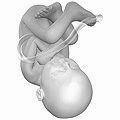Position, position and holding of the fetus
From WikiLectures
Fetal position (situs)[edit | edit source]
The relationship of the long axis of the fetus to the longitudinal axis of the uterus shows the greatest stability after the 30th week of pregnancy, the most changes in situ at the end of the 20th week.
- longitudinal position of the fetus - both axes are parallel (the fetus is head down or pelvic end),
- transverse position of the fetus - the axes form a right angle,
- oblique position of the fetus - it is not stable, it turns into a longitudinal or transverse axis.
The normal course of birth is only possible with the longitudinal axis of the fetus.
Fetal position (positio)[edit | edit source]
The relationship of the back of the fetus to the front edge of the uterus.
- Left fetal position – the back presses against the left edge.
- The uterus is more often in dextrotorsion → the back of the fetus is directed forward → left anterior = I. ordinary position of the fetus'.
- Less often, the uterus in sinistrotorso → the back points backwards → 'left posterior = I. less common position of the fetus.
- Right position of the fetus – the back presses against the right edge.
- Uterus in dextrotorsion → 'right posterior = II. ordinary fetal position.
- Uterus in sinistrotorso → 'right anterior = II. less common fetal position.
- Transverse position – the position of the header is decisive.
- Head left → I. position.
- Head right → II. position.
- Back in front → dorsoanterior position.
- Back at the back → dorsoposterior position.
Holding the fetus (habitus)[edit | edit source]
- Mutual relationship of individual parts of the fetus.
- The fetus should take up as little space as possible in the uterus (that's why it has the shape of an egg).
- Back bent, head in flexion, chin pressed to the chest, HK in flexion crossed on the chest, DK flexed, crossed, thighs close to the belly, heels to the buttocks.
Fetal insistence (presentatio)[edit | edit source]
The relationship of the fetal body to the pelvic inlet. The most common is the longitudinal position and the head presses on the pelvic inlet. The header can insist on the entrance:
- indifferently – both fontanelles (small and large) are at the same height;
- centrically − the head is equidistant from the linea terminalis in the center of the pelvic entrance;
- synclitically − both parietal bones press against the entrance with the same surface[1].
Links[edit | edit source]
External links[edit | edit source]
References[edit | edit source]
- MALÍNSKÝ, Jiří – LICHNOVSKÝ, Václav. An overview of human embryology in pictures. 2. edition. Palacky University in Olomouc, 2001. 176 pp. ISBN 80-244-0243-2.
References[edit | edit source]
- ↑ KOBILKOVÁ, Jitka. Fundamentals of Gynecology and Obstetrics. 1. edition. Galén, 2005. 368 pp. pp. 231. ISBN 80-7262-315-X.



